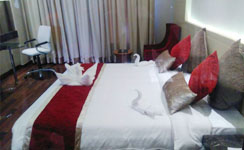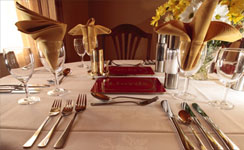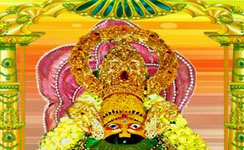|
||||||||||||||||||||||||
 |
||||||||||||||||||||||||
 |
||||||||||||||||||||||||
|
Discovery of Sheesh in Khatu :
After the Mahabharata battle, Barbarika’s head
(Sheesh) was buried in
the village ( Khatu ) in Sikar District
. The location was obscured until well after the Kaliyuga period began.
Then, on one
time, milk started flowing suddenly out
 of a
cow’s udder when she neared the burial spot. surprised at this
incident,
the local villagers dug the spot the buried head of Barbarik was discovered. of a
cow’s udder when she neared the burial spot. surprised at this
incident,
the local villagers dug the spot the buried head of Barbarik was discovered.
The head
was handed over to a Brahmin who worshipped it for many
days.
Roopsingh Chauhan, king of that time of Khatu, then had a dream where
he was motivated to build a temple and set up
the head there.
Afterward, a temple was built and the idol was installed on the 11th day
of the Shukla Paksha (bright half) of
the month of Kartik.
After establishing this temple countless miracles done here and a lot
of bhagats come to observe this
khatu shyam ji
temple.
Shyam Kund’s Story
There is
another, only a little different
version of this legend.
Roopsingh Chauhan was the ruler of Khatu. His wife, Narmada Kanwar,
once had a dream in which the holy
being instructed her to
take his illustration out of the earth. The indicated place (now known
as Shyam Kund) when then dug
up. Sure enough, it yielded the
idol, which was appropriately enshrined in the temple.
Khatu Temple History
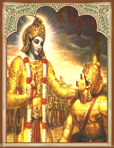 The original temple was built in 1027 AD by Roopsingh
Chauhan and his wife Narmada Kanwar. In 1720 AD,
a nobleman
known as Diwan Abhaisingh renovated the old temple, at the behest of the
then ruler of Marwar. The temple took its
present shape at
this time and the idol was enshrined in the sanctum sanctorum. The
idol is made of rare stone. Khatushyam is
the family deity of
a large number of families.The temple is constructed of pure white
Makrana marble and is an example of
unique architecture. The
idol is in form of a head "SHISH" which appeared in the holy
pond as Shyam Kund.
The
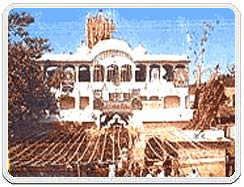 "SHISH"
was retrieved and was instituted in
the temple Architectural
features The temple is architecturally rich. Lime mortar, marble and
tiles have been used in constructing the structure. The shutters of
the sanctum sanctorum are
beautifully covered with silver
sheet. Outside is the prayer hall, named Jagmohan. its walls are highly
painted, depicting
legendary scenes. The entrance gate and
exit gate are made of marble; their brackets are also of marble and
feature ornamental
floral designs Precincts . "SHISH"
was retrieved and was instituted in
the temple Architectural
features The temple is architecturally rich. Lime mortar, marble and
tiles have been used in constructing the structure. The shutters of
the sanctum sanctorum are
beautifully covered with silver
sheet. Outside is the prayer hall, named Jagmohan. its walls are highly
painted, depicting
legendary scenes. The entrance gate and
exit gate are made of marble; their brackets are also of marble and
feature ornamental
floral designs Precincts .
There is an open space
in front of
the entrance gate of the temple. The Shyam Bagicha
is a garden near the temple from where flowers are picked to be
offered to
the god. The Samadhi of Aloo Singh,(a great
devotee), is located within the garden. The Gopinath temple lies to the
south-
east of the main temple. The Gaurishankar temple also
lies nearby. There is an interesting tale associated with the
Gaurishankar temple. It is said that some soldiers of the mughal
emperor Aurangzeb wanted to destroy this temple. They
attacked
the Shiva lingam enshrined within this temple with their spears.
Immediately, fountains of blood appeared from the
Shiva Linga.
The soldiers ran away, terrified. One can still see the mark of the
spear on the Lingam.
Temple Timings:
|
||||||||||||||||||||||||
|
Khatu : 17 kms. from
Ringas. |
||||||||||||||||||||||||
|
||||||||||||||||||||||||
|
||||||||||||||||||||||||
|
HOME I ABOUT US I ROOMS AND TARIFF I FACILITIES I PHOTO GALLERY I CONTACT US I ABOUT KHATU SHYAM JI I TOURISM |
||
|
|
Copyright 2015 Hotel Lakhdatar I email: info@hotellakhdatar.com |
|
|
Website design and develop by Next Wave India |
||

